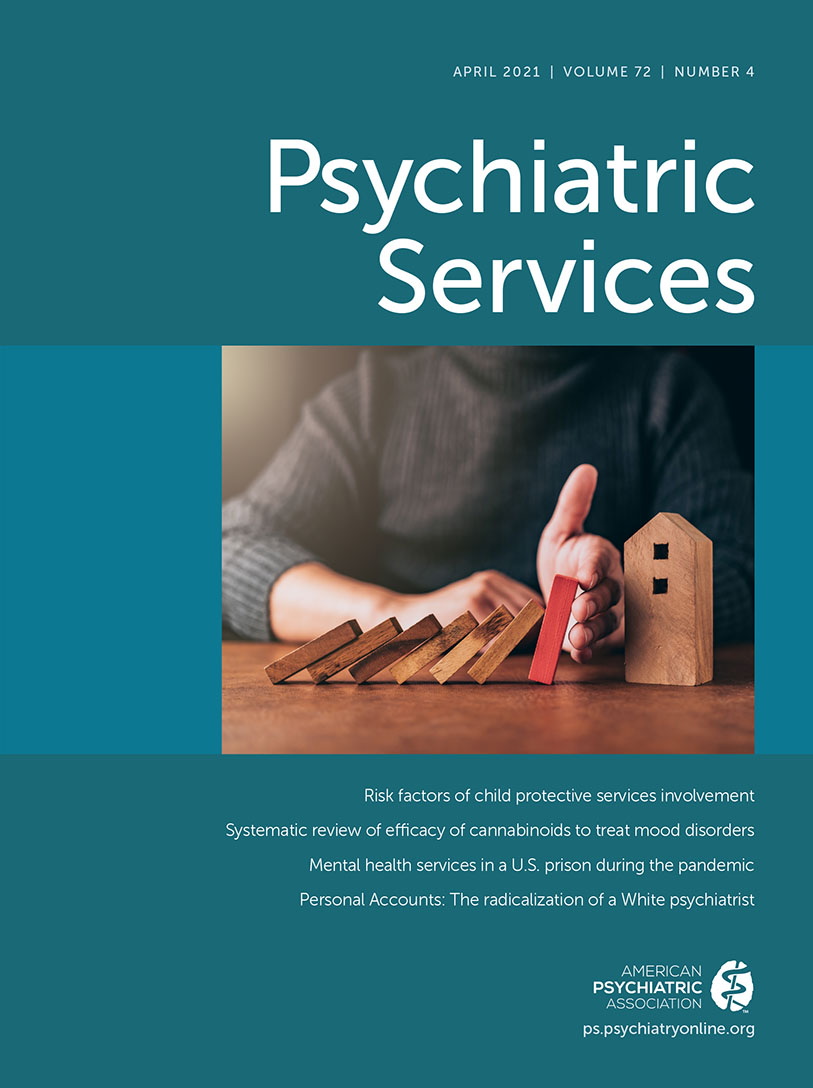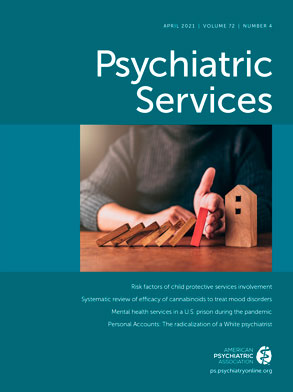The quality of acute inpatient care is a matter of international debate. Three important reforms are visible in psychiatry in the Netherlands and elsewhere (
1). First, coercive measures in mental health care, such as seclusion and forced medication, are controversial. Coercion has a large impact on patients and health care professionals, and evidence of its therapeutic effects is lacking (
2). In 2001, a set of quality criteria concerning seclusion was developed in the Netherlands, shifting the attention from the legal justification of coercion to the ethical question of how to provide good care and prevent coercion. In 2006, the Dutch Association of Mental Health and Addiction Care (GGZ Nederland) formulated the goal of reducing seclusion by 10% yearly. With financial support from the government, 34 mental health institutions in the Netherlands initiated projects to reduce the number and duration of instances of seclusion (
3). Through new methods and organizational changes, a reduction in instances of seclusion was achieved, albeit not as large as was sought (
4). The second relevant development in the Netherlands was the government policy to reduce the number of psychiatric beds. The so-called (flexible) assertive community treatment approach was adopted, putting emphasis on outpatient-centered care and involving the patient’s social network (
5). The threshold for patients to be admitted to a mental health care institute increased. As a result, however, the condition in which patients were admitted was often more severe, increasing the need for intensive care. The third important development in mental health care was the emphasis on recovery and being in control instead of full symptom reduction (
6). Together, these developments put new demands on inpatient care.
In response to these demands, a new approach to intensive care in acute psychiatry was developed: the high and intensive care (HIC) model. The HIC model can be considered a “complex intervention” because of the diversity of the elements involved as well as its combination of a traditional clinical hospitalization and a community care and social psychiatry approach. The model is partly inspired by the psychiatric intensive care units (PICUs) developed in the United States and the United Kingdom. PICUs are defined as small wards with a high proportion of nursing staff, built on an open plan to ease observation, sometimes with facilities for seclusion (
7). The HIC model also focuses on cooperation with outpatient care; stepped care; and contact between staff, patients, and relatives.
This column describes the development of a novel strategy aimed at the reduction of inpatient admissions and coercion. We describe the process and the lessons learned, and we provide concluding comments and a discussion of the strategy’s implications.
Process Description
In 2011, a literature study about methods and interventions aimed at the reduction of coercion was performed, resulting in a narrative synthesis. In addition, interviews and focus groups to discuss initiatives, successes, and bottlenecks were conducted in 26 mental health care hospitals in the Netherlands (
8). The literature study and the qualitative data from the interviews and focus groups resulted in a proposal for a new approach to inpatient care: the HIC model. The model contains a structured set of requirements for the organization of inpatient care, including team structure, team process, treatment (interventions), organization of care, monitoring, professionalization, facilities, and (evaluation of) coercive measures. In three 2-day expert meetings with participants from 15 mental health care institutions in the Netherlands, the proposal was discussed, and the model was refined. Four psychiatrists, four nurses, two patients, two representatives of family organizations, two psychologists, two managers, and four researchers were present. The participating groups contributed on the basis of their experience and expertise. Patients mentioned the importance of recovery-oriented care and the involvement of peer workers. Family representatives emphasized cooperation with relatives and the possibility to stay overnight (rooming in). Nurses indicated that development of knowledge and skills is required to provide good care to patients in complex situations. Psychiatrists stressed the need for clear admission criteria and for giving attention to various treatment options (including medication) in the model. In several meetings, the model was presented to professionals and to patients and their families in all mental health care institutions in the Netherlands to elicit feedback and create support in the field. A writing team, working closely together over 3 months, described the model in a handbook. A model fidelity scale describing specific elements of the model was developed, which enables measurement of the level of implementation. This scale has been validated (
9).
Lessons Learned
The main goal of the HIC approach is to provide optimal treatment and safety while restoring and maintaining contact between staff, patients, and relatives and promoting crisis prevention. Its aim is to provide safe, protective, and respectful care. Core characteristics of the HIC model are as follows.
Stepped care.
The HIC model is based on the principles of stepped care. Admission is initiated by professionals in outpatient care only when care and support in the community are no longer possible. In the ward, the patient is admitted into the high care unit (HC), consisting of single-patient rooms, shared living areas, and a comfort room. If stress and anxiety rise, or whenever aggression is imminent, the patient can be accompanied to the intensive care unit (ICU) in the same ward. The ICU consists of large single-patient rooms where patients receive one-on-one care. Transfer to the ICU is limited to a maximum of 3 days. There is no staff for the ICU, which means that one of the nurses from the HC accompanies the patient to the ICU. The nurse will stay with the patient in the ICU full-time. In most cases, the patient settles down after a few hours in the ICU and can then return to the HC. When safety in the ICU is at stake, the high security room (HSR) can be used. The HSR is a locked room, which means that using it is a coercive measure. Thus, the HSR is a last resort.
Process of admission, treatment, and care.
Six phases in the process of admission, treatment, and care are defined. The first phase is getting acquainted. The patient and his or her relatives are welcomed to the ward, building rapport and trust. The second phase is risk assessment and crisis prevention. Within the first hour of admission, the nurse responsible for the patient carries out an assessment of risk of suicide and violent behavior. Structured risk assessment occurs daily during the entire admission, for example, by means of the crisis monitor. The third phase is psychiatric assessment. Directly after admission, the psychiatrist performs a psychiatric examination, including a family history, and information from the personal health record of the patient is retrieved. In the fourth phase, somatic assessment, the psychiatrist also performs a physical examination, including exploratory neurological assessment and laboratory tests. The fifth phase is treatment planning. The previous steps are integrated in a treatment plan to be drafted within 24 hours of admission. If possible, the treatment plan is developed with the patient. Finally, the sixth phase is the care planning meeting, organized within 24 hours after admission with the patient, relatives, the outpatient psychiatrist, and the HIC psychiatrist. In this meeting, treatment, time scales, and the division of tasks are discussed.
Medical and recovery approaches.
The HIC model combines a medical approach and a recovery approach. Medical diagnosis and treatment aim to enable the patient to regain control in moments of crisis. It is seen as a necessary, but not sufficient, approach for the patient’s recovery. According to Anthony (
6), recovery is “a deeply personal, unique process of changing one’s attitudes, values, feelings, goals, skills, and/or roles. It is a way of living a satisfying, hopeful, and contributing life even with limitations caused by illness. Recovery involves the development of new meaning and purpose in one’s life as one grows beyond the catastrophic effects of mental illness.”
Professional and experiential knowledge.
The HIC team combines professional and experiential knowledge. Psychiatrists, nurses, psychologists, nursing specialists, and occupational therapists bring in professional knowledge. Experiential knowledge in the team is guaranteed by peer providers. The team collaborates with significant others, such as family and neighbors of the patient, using their experience and expertise. Training of professionals focuses not only on the increase of knowledge and the development of professional skills but also on taking into account experiential knowledge and developing core qualities such as relational skills.
Healing environment.
The HIC ward is designed according to the principles of a healing environment, thereby promoting recovery and well-being and reducing stress, anxiety, and aggression.
Discussion and Implications
The HIC model entails a new approach to mental health care in the Netherlands. It resembles the PICU model, in that it focuses on early risk assessment, de-escalation, and use of an ICU (extra care area in the PICU model). However, the HIC model is also different. First, admission is seen as a temporary break in outpatient care, and the outpatient care team is directly involved in the care planning meetings. Second, the HIC model also utilizes stepped care within the ward, using the ICU and the HSR only when needed. Third, the HIC model, unlike the PICU model, aims to minimize coercion. Thus, the core characteristics of the HIC model correspond with the three reforms in psychiatry in the Netherlands mentioned above. The HIC model aims to reduce coercion by focusing on contact and cooperation between staff, patients, and family. It is complementary to outpatient care, aiming for continuity between community and inpatient care. It integrates principles of recovery with a medical approach, making recovery a cornerstone of inpatient care.
During the process of developing the HIC model, we learned various lessons. First, support is needed of all stakeholders, especially of core opinion leaders in psychiatry. Second, all participants should be actively involved in the process. By presenting the development of HIC as special, we ensured that participants felt honored to be able to contribute. During the meetings, we continuously focused on learning from and with each other. This approach inspired participants and led to new insights that participants then discussed at their own institutions. Finally, the elements of the model should be concrete. We achieved this aim by developing a model fidelity scale describing key components. This scale provided support in implementing HIC. These lessons can be useful for others who want to develop a similar strategy.
Because the HIC model was the result of a bottom-up process of development that included professionals, user organizations, management, and patient and family representatives, the model is widely accepted and has been implemented in Dutch mental health care. Further research is needed to investigate the process of implementation and the effects on reduction of coercion, quality of care, continuity of care, and recovery.

